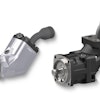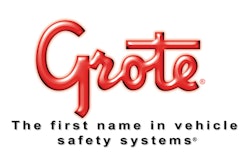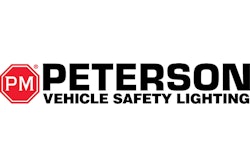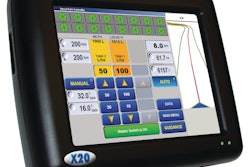
As the oldest and best-known desert race, the Tecate SCORE Baja 1000 wages intrepid humans and fast vehicles against 1,000 miles of the Baja California peninsula. Far from pressing the pedal to the metal and turning left, the Baja 1000 course is a mixture of pavement, rock, desert, dry lake beds and traps set by spectators who may wander onto the course at anytime.
Chris Walton wrote in Motor Trend magazine that driving the Baja 1000 "felt like an endless string of unconsummated car wrecks."
The 2006 event was held in November. Among the hundreds of participants was Kevin Ostlund, president of High Rollerz Trux Inc., an off-road accessory distributor in Okotoks, Alberta, Canada. As Ostlund drove Team Canada Racing's diesel-engined Dodge Ram 2500 to the starting line, not only was he a Baja 1000 rookie, it was his first time in the desert. Mounted to the front of the truck were three prototype light-emitting diode (LED) lamps that helped Ostlund and co-driver Richard Thomas select the correct path through choking dust and hours of darkness. It was the first time LED lights, with the output of a high-intensity discharge light, were used as forward lighting in the Baja 1000.
"There was only one prototype available, and the supplier opted to put it on our truck. I think that was because we had the nicest looking machine," laughs Ostlund. The bright white light generated by the 36-unit LED panels allowed Ostlund to push the truck to 80 mph in off-road conditions at night.
The Baja 1000 could be considered the ultimate test from a purely mechanical point of view. "The cool thing about Baja is it doesn't matter how much money your team has; it dictates what happens to you," says Ostlund. The team was knocked out of the event at mile 660 when the truck's turbocharger came apart.
The LED light array on the front of the Dodge was provided by Baja Designs, San Marcos, CA, one of the team's sponsors. Baja Designs supplies lights to off-road racing and driving enthusiasts.
‘The whiteness of the lights and their broad spectrum made the LEDs incredible for seeing the trails," says Ostlund. "In many of the heavy silt-bed areas, we would turn the roof-mounted HID and factory headlights off and run the LEDs. They seemed to penetrate the dust better than the HIDs."
The headlights were developed for Baja Designs by Luxi Lighting. Luxi is a joint venture formed in 2005 by safety system specialist Grote Industries, Madison, IN, and a Spanish automotive lighting company, Rinder Group.
The joint venture was a perfect fit. "There wasn't much overlap in the expertise of the two companies," says John Grote, Luxi managing director, Guernica, Spain.
Although Grote Industries has worked with off-highway equipment OEMs for decades, its focus has been on heavy-duty trucks. Luxi's task, as the commercial arm of Grote and Rinder, is to bring LED and high-intensity discharge (HID) lights to the heavy-duty mobile equipment industry, including off-highway equipment.
"Industries such as forestry and mining are screaming for LED lights," says Grote. "I can see machines eventually being lit with only LEDs."
When machines subjected to never-ending shock and vibration are required to work beyond sunset, downtime due to tiny, broken filaments can be avoided with LED lights. LEDs utilize solid-state technology similar to that of microprocessors and have no moving parts and no glass or wire filament to break. They generate less heat than a comparable HID light and require less power to operate.
Long life, fast evolution
One of the greatest advantages of an LED light over a filament bulb is its long life. For a standard 1157 light bulb with two filaments, the lifespan is 5,000 hours for the minor filament (taillight) and 1,200 hours for the major filament (brake and turn signal).
Compare that to a red LED, which is rated at 100,000 hours. That's more than a decade of lighting-the-way night after night. When their time is up, LEDs gradually degrade in performance rather than go dark immediately.
Infrared light-emitting diodes were used in sensors and scientific instruments in the 1960s. Next came red, green, yellow, blue and most recently, white. Motorists first started seeing red LEDs on over-the-road trailers and on buses.
"The LED industry has Haitz's Law, which says the output of an LED is going to double every three to five years while the price goes down. Haitz Law is a reality," says Brad Van Riper, senior vice president and chief technology officer, Truck-Lite, Falconer, NY, and a member of the Transportation Safety Equipment Institute (TSEI).
Haitz is Dr. Roland Haitz, who retired as R&D manager for what is now Philips Lumileds.
"A few years ago we were using white LEDs to make license plate lights," says Van Riper. "As high-intensity white lights improve, new applications become feasible."
One of the tasks of TSEI, comprised of light firms, has been to monitor the industry. "We are seeing a huge influx of non-compliant product entering the U.S. market, which is typically not marked with information that would allow the user to locate the manufacturer," says Van Riper. "TSEI has asked its members to voluntarily mark their products per SAE guidelines."
Lights in white
Creating an LED component that would cast white light wasn't easy. Basic light color theory says that red, green and blue are the primary colors, and combined they create white. LEDs produce only one color.
"LEDs are monochromatic, "says Van Riper. "Red LEDs only produce red light. If you put a yellow filter over the diode it will still look red. The same is true for green or blue LEDs."
To create white light, manufacturers tried lights made from multiple-chip diodes of red, green and blue. The blue color was weak, so they added two blue chips. The LEDs were designed to mix the monochromatic red, green and blue light to fill out the color spectrum and create white. The white light this method generated wasn't good enough.
A solution was found with the marriage of new, improved blue diodes with a phosphor. "When the phosphor sees the blue wave length light," says Van Riper, "it excites the phosphor which releases photons to fill out the light spectrum." From that core discovery, white LED technology was born.
Bright future
Over the 1990s and into the current decade, companies such as Truck-lite have seen a gradual gain in market share for LED technology as "customers who closely monitor their fleet maintenance costs realize that this is the technology of choice in terms of providing the lowest cost per mile in their light systems, " says Van Riper.
Based in San Jose, CA, Philips Lumileds supplies the diodes to lighting manufacturers. One outcome from the firm's technology is a headlamp comprised of a small number of LEDs that meet stringent color and reliability requirements.
When it drives onto the market in late 2007, Audi's mid-engined 420 hp sports car, the R8, will be the first production automobile to employ LEDs as headlights (although North America will not get the extra-cost option. It gets the standard LED daytime running lamps with xenon headlights).
Audi reports that the functional advantages of the LED headlights include the light's resemblance to daylight to help prevent fatigue at night.
The small size and variability of LED lights allowed Audi's designers to work the headlights into the make's trademark grille design. This creative aspect is another "big advantage of LEDs, as is it permits the designer to be creative with the design of the machine," says Luxi's John Grote. "Designers can work lights into a design rather than work the design into lights."
The off-highway industry often adopts technology that has been proven in the high-volume automobile industry. Currently, the majority of the lights Superior Signals Inc. (SSI) sells are incandescent, but Jerod C. Newcomb, product manager, predicts that within a few years there will be a dramatic increase in the use of LED lights in mobile equipment.
Over the last year SSI has focused a good portion of its product development efforts on new LED warning lights. SSI does all of its engineering, testing and manufacturing at its Olathe, KS, facility. Newcomb says a lot of that work will be introduced this year.
"As technology advances, so does the price need to decrease," says Newcomb. "There is still an economic advantage with the initial purchase of a filament bulb fixture compared to one with LEDs. We are educating our customers to see the overall advantage of switching to LED. When the technology sells in higher quantity the price comes down." The number of standard lights with high-volume sales in trucking help keep costs down.
Much of SSI's work has been in lens design. "LED is a line-of-sight type of light," says Newcomb. We have put some of our work into the lens, so you don't necessarily have to be standing directly in front of the light to get the full effect."
"Tricking" diodes into generating white light is an engineering challenge that makes white-light LEDs more expensive to manufacture and less efficient than colored-light diodes. HID lamps, on the other hand, intrinsically produce very bright, white light. HID tends to be a good choice for very bright, long-distance lights. However, white-light LED worklights have many benefits, despite a typically lower overall light output compared to HID. For off-highway use, where regulatory requirements and vehicle speeds often permit lower overall output, LED worklights are attractive due to their even light dispersal.
"The safety lighting market has shifted dramatically from incandescent bulbs to LEDs over the past decade," says Peter Zilliox, publications specialist, Peterson Mfg., Inc., Grandview, MO. "That market shift continues to accelerate. We expect LEDs to be the dominant technology in safety lighting for the foreseeable future. We don't expect HIDs to have much of a presence in safety lighting applications. HIDs will be restricted to applications where higher output is required, such as forward lighting and spotlights. White-light diodes continue to get brighter and cheaper, so LEDs will also share some of this market — mostly in task lighting with lower output demands, such as wide-pattern floods."



















